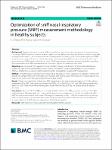Item Infomation
Full metadata record
| DC Field | Value | Language |
|---|---|---|
| dc.contributor.author | R. J., Wilding | - |
| dc.contributor.author | M., Thynne | - |
| dc.contributor.author | M. M. F., Subhan | - |
| dc.date.accessioned | 2023-03-22T07:03:25Z | - |
| dc.date.available | 2023-03-22T07:03:25Z | - |
| dc.date.issued | 2023 | - |
| dc.identifier.uri | https://link.springer.com/article/10.1186/s12890-023-02348-0 | - |
| dc.identifier.uri | https://dlib.phenikaa-uni.edu.vn/handle/PNK/7056 | - |
| dc.description | CC BY | vi |
| dc.description.abstract | Maximal inspiratory pressure (MIP) is currently the most commonly used measure for respiratory muscle strength (RMS) estimation, however, requires significant effort. Falsely low values are therefore common, especially in fatigue-prone subjects, such as neuromuscular disorder patients. In contrast, sniff nasal inspiratory pressure (SNIP) requires a short, sharp sniff; this is a natural manoeuvre, decreasing required effort. Consequently, it has been suggested that use of SNIP could confirm the accuracy of MIP measurements. However, no recent guidelines regarding the optimal method of SNIP measurement exist, and varied approaches have been described. | vi |
| dc.language.iso | en | vi |
| dc.publisher | Springer | vi |
| dc.subject | Maximal inspiratory pressure | vi |
| dc.subject | sniff nasal inspiratory pressure | vi |
| dc.title | Optimization of sniff nasal inspiratory pressure (SNIP) measurement methodology in healthy subjects | vi |
| dc.type | Book | vi |
| Appears in Collections | ||
| OER- Y học- Điều dưỡng | ||
Files in This Item:

